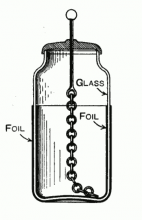One of the oldest instruments of the museum collection placed to the mid 19th century.
It was invented independently by German cleric Ewald Georg von Kleist on 11 October 1745 and by Dutch scientist Pieter van Musschenbroek of Leiden (Leyden) in 1745–1746. The invention was named after the city.
The Leyden jar was used to conduct many early experiments in electricity, and its discovery was of fundamental importance in the study of electrostatics. The Leyden jar was the first means of storing an electric charge which then could be discharged at the experimenter's will. Leyden jars are still used in education to demonstrate the principles of electrostatics.
The original form of the device was just a glass bottle partially filled with water, with a metal wire passing through a cork closing it. The role of the outer plate was provided by the hand of the experimenter. Soon it was found that it was better to coat the exterior of the jar with metal foil, leaving the (accidentally) impure water inside acting as a conductor, connected by a chain or wire to an external terminal, a sphere to avoid losses by corona discharge. Later the water inside was replaced with a second metal foil lining.
In the museum's collection Leyden Jar the metal connects to a hook, on the top of the jar to be connected to an electostatic generator.


